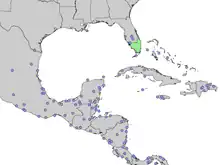| Chrysobalanus icaco | |
|---|---|
.jpg.webp) | |
| Chrysobalanus icaco leaves and flowers | |
| Scientific classification | |
| Kingdom: | Plantae |
| Clade: | Tracheophytes |
| Clade: | Angiosperms |
| Clade: | Eudicots |
| Clade: | Rosids |
| Order: | Malpighiales |
| Family: | Chrysobalanaceae |
| Genus: | Chrysobalanus |
| Species: | C. icaco |
| Binomial name | |
| Chrysobalanus icaco | |
 | |
| Distribution | |
| Synonyms[2] | |
| |
Chrysobalanus icaco, the cocoplum, paradise plum, abajeru or icaco, is a low shrub or bushy tree found near sea beaches and inland throughout tropical Africa, tropical Americas and the Caribbean, and in southern Florida and the Bahamas.[2] An evergreen, it is also found as an exotic species on other tropical islands, where it has become a problematic invasive.[3] Although taxonomists disagree on whether Chrysobalanus icaco has multiple subspecies or varieties, it is recognized as having two ecotypes, described as an inland, much less salt-tolerant, and more upright C. icaco var. pellocarpus and a coastal C. icaco var. icaco.[4][5] Both the ripe fruit of C. icaco, and the seed inside the ridged shell it contains, are considered edible.[5]
Description
Chrysobalanus icaco is a shrub 1–3 metres (3.3–9.8 ft), or bushy tree 2–6 metres (6.6–19.7 ft), rarely to 10 metres (33 ft). It has evergreen broad-oval to nearly round somewhat leathery leaves (3 to 10 cm long and 2.5 to 7 cm wide). Leaf colors range from green to light red. The bark is greyish or reddish brown, with white specks.
The clustered flowers are small, greenish-white, and appear intermittently throughout the year but more abundantly in late spring. The fruit that follows (a drupe) is variable, with that of the coastal form being round, up to 5 cm in diameter, white, pale-yellow with a rose blush or dark-purple in color, while that of the inland form is oval, up to 2.5 cm long, and dark-purple. The fruit is edible, with an almost tasteless to mildly sweet flavor, and is sometimes used for jam. It contains a five- or six-ridged brown stone with an edible white seed. The common name for this fruit in Barbados, Trinidad and Tobago and Guyana is "fat pork". The seed's kernel is used ground into a powder and dried, as a spice (variously called gbafilo, itsekiri, umilo,emilo or omilo) as part of West African Pepper Soup Mix.[6]
Chrysobalanus icaco is unable to survive a hard frost, but is planted as an ornamental shrub in subtropical regions due to its appearance, easily manageable size, and tolerance of shallow and variable soils (for example, as alkaline as pH 8.4[5]) and partial shade.[7][4] Several cultivars are available:
- 'Red Tip' is of the inland ecotype, and is the most commonly planted in Florida, often as a hedge. It is a chance occurrence that has pink new growth.
- 'Green Tip' is another example of the inland type that has green new growth.
- 'Horizontal' is of the coastal type, and tends to root wherever its creeping branches touch the ground, creating clumps over time that can help stabilize the soil. Combined with the high salt tolerance of the coastal ecotype, this characteristic means it can be planted to stabilize beach edges and prevent erosion.[5]
Chrysobalanus icaco plays a role in traditional medicine in some parts of its native range, and has been the subject of scientific investigations that have provided evidence of hypoglycemic, antioxidant, antifungal and other pharmacological properties of the leaf extract.[4][8][9]
Gallery
 Fruit of the coastal form
Fruit of the coastal form Red leaves on the inland form
Red leaves on the inland form Fruit and branches of cocoplum growing in Oleta River State Park on Biscayne Bay in North Miami, Florida -
Fruit and branches of cocoplum growing in Oleta River State Park on Biscayne Bay in North Miami, Florida - Detail of branches
Detail of branches Mature and immature fruits
Mature and immature fruits
References
- ↑ Botanic Gardens Conservation International (BGCI); IUCN SSC Global Tree Specialist Group. (2019). "Chrysobalanus icaco". IUCN Red List of Threatened Species. 2019: e.T72231760A149056791. doi:10.2305/IUCN.UK.2019-2.RLTS.T72231760A149056791.en. Retrieved 13 November 2022.
- 1 2 Kew World Checklist of Selected Plant Families
- ↑ Chrysobalanus icaco at Pacific Island Ecosystems at Risk (PIER)
- 1 2 3 "Chrysobalanus icaco—Coco-plum", Francis, John K., U.S. Department of Agriculture, Forest Service, International Institute of Tropical Forestry, San Juan PR
- 1 2 3 4 Brown et al, Lee County Extension, Institute of Food and Agricultural Services extension, University of Florida
- ↑ "On Pepper Soup Spice and Finding Names". Kitchen Butterfly. 21 August 2018. Retrieved 22 August 2021.
- ↑ Chrysobalanus icaco—Cocoplum, Institute of Food and Agricultural Services, University of Florida
- ↑ Presta, Giuseppe Antonio et al. (2007). Effects of Chrysobalanus icaco on the labeling of blood constituents with technetium-99m and on the shape of the red blood cells. Brazilian Archives of Biology and Technology, 50(spe), 145-152.
- ↑ Bastos Silva, João Paulo et al. (2017). Antifungal activity of hydroalcoholic extract of Chrysobalanus icaco against oral clinical isolates of Candida Species. Pharmacognosy Research, 9, 96-100.
Bush, Charles S. and Morton, Julia F. (1969) Native Trees and Plants for Florida Landscaping (pp. 64–65). Bulletin No. 193. Department of Agriculture - State of Florida.
External links
- Cocoplum at Virginia Tech Dendrology
- Dressler, S.; Schmidt, M. & Zizka, G. (2014). "Chrysobalanus icaco". African plants – a Photo Guide. Frankfurt/Main: Forschungsinstitut Senckenberg.
